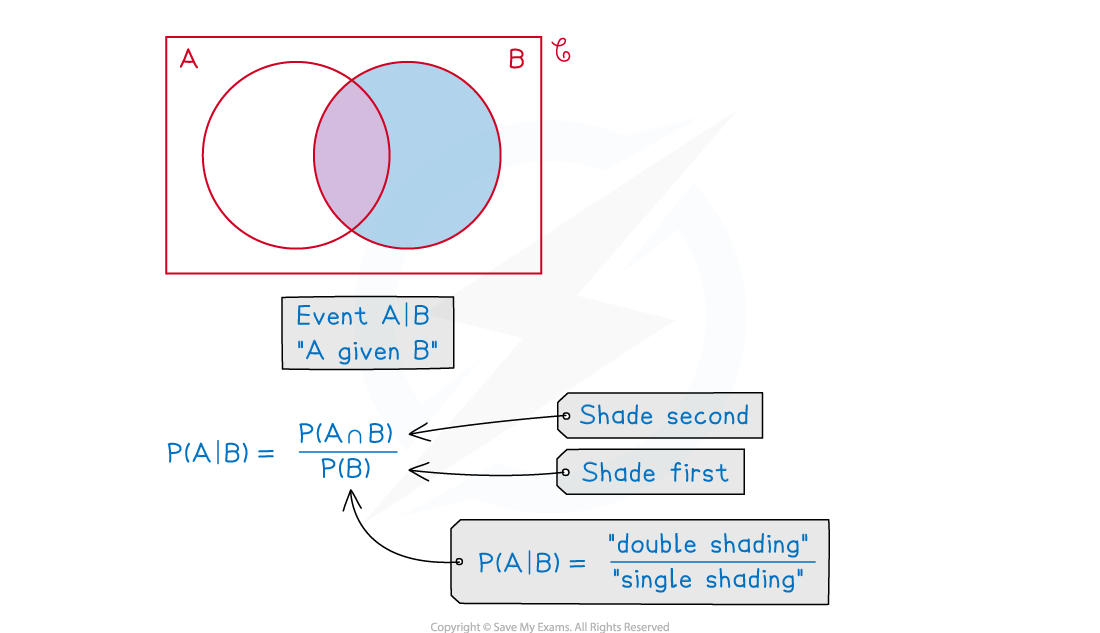Venn Diagrams
What is a Venn diagram?
- A Venn diagram is a way to illustrate events from an experiment and are particularly useful when there is an overlap between possible outcomes
- A Venn diagram consists of
- a rectangle representing the sample space (U)
- The rectangle is labelled U
- Some mathematicians instead use S or ξ
- a circle for each event
- Circles may or may not overlap depending on which outcomes are shared between events
- a rectangle representing the sample space (U)
- The numbers in the circles represent either the frequency of that event or the probability of that event
- If the frequencies are used then they should add up to the total frequency
- If the probabilities are used then they should add up to 1
What do the different regions mean on a Venn diagram?
is represented by the regions that are not in the A circle
is represented by the region where the A and B circles overlap
is represented by the regions that are in A or B or both
- Venn diagrams show ‘AND’ and ‘OR’ statements easily
- Venn diagrams also instantly show mutually exclusive events as these circles will not overlap
- Independent events can not be instantly seen
- You need to use probabilities to deduce if two events are independent


How do I solve probability problems involving Venn diagrams?
- Draw, or add to a given Venn diagram, filling in as many values as possible from the information provided in the question
- It is usually helpful to work from the centre outwards
- Fill in intersections (overlaps) first
- If two events are independent you can use the formula
- To find the conditional probability
- Add together the frequencies/probabilities in the B circle
- This is your denominator
- Out of those frequencies/probabilities add together the ones that are also in the A circle
- This is your numerator
- Evaluate the fraction
- Add together the frequencies/probabilities in the B circle

Exam Tip
- If you struggle to fill in a Venn diagram in an exam:
- Label the missing parts using algebra
- Form equations using known facts such as:
- the sum of the probabilities should be 1
- P(A∩B)=P(A)P(B) if A and B are independent events
Worked Example
40 people are asked if they have sugar and/or milk in their coffee. 21 people have sugar, 25 people have milk and 7 people have neither.
a)
Draw a Venn diagram to represent the information.

b)
One of the 40 people are randomly selected, find the probability that they have sugar but not milk with their coffee.

c)
Given that a person who has sugar is selected at random, find the probability that they have milk with their coffee.

Tree Diagrams
What is a tree diagram?
- A tree diagram is another way to show the outcomes of combined events
- They are very useful for intersections of events
- The events on the branches must be mutually exclusive
- Usually they are an event and its complement
- The probabilities on the second sets of branches can depend on the outcome of the first event
- These are conditional probabilities
- When selecting the items from a bag:
- The second set of branches will be the same as the first if the items are replaced
- The second set of branches will be the different to the first if the items are not replaced
How are probabilities calculated using a tree diagram?
- To find the probability that two events happen together you multiply the corresponding probabilities on their branches
- It is helpful to find the probability of all combined outcomes once you have drawn the tree
- To find the probability of an event you can:
- add together the probabilities of the combined outcomes that are part of that event
- For example:
- For example:
- subtract the probabilities of the combined outcomes that are not part of that event from 1
- For example:
- For example:
- add together the probabilities of the combined outcomes that are part of that event

Do I have to use a tree diagram?
- If there are multiple events or trials then a tree diagram can get big
- You can break down the problem by using the words AND/OR/NOT to help you find probabilities without a tree
- You can speed up the process by only drawing parts of the tree that you are interested in
Which events do I put on the first branch?
- If the events A and B are independent then the order does not matter
- If the events A and B are not independent then the order does matter
- If you have the probability of A given B then put B on the first set of branches
- If you have the probability of B given A then put A on the first set of branches
Exam Tip
- In an exam do not waste time drawing a full tree diagram for scenarios with lots of events unless the question asks you to
- Only draw the parts that you are interested in
Worked Example
20% of people in a company wear glasses. 40% of people in the company who wear glasses are right-handed. 50% of people in the company who don’t wear glasses are right-handed.
a)
Draw a tree diagram to represent the information.

b)
One of the people in the company are randomly selected, find the probability that they are right-handed.

c)
Given that a person who is right-handed is selected at random, find the probability that they wear glasses.

